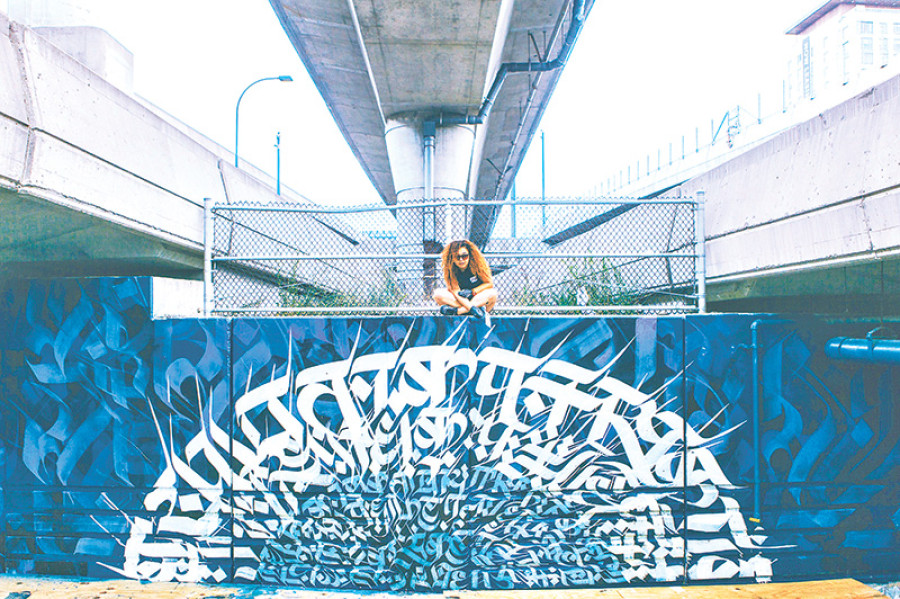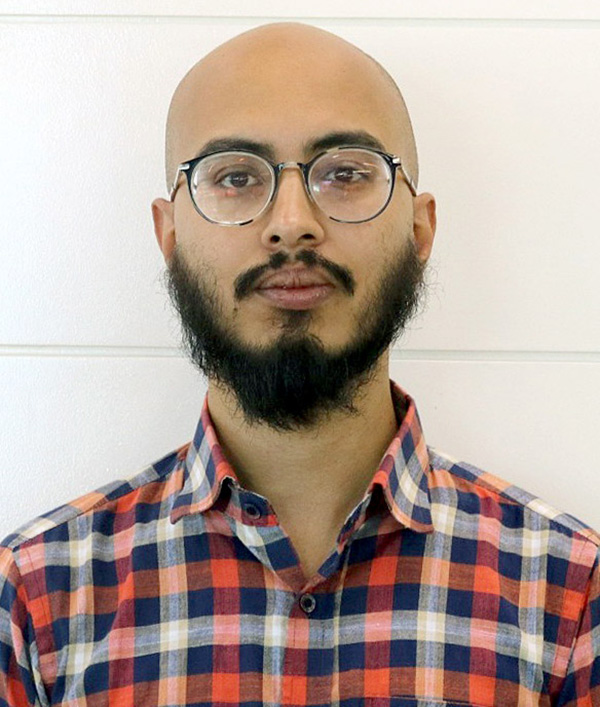Miscellaneous
Writing on the wall
Sneha Shrestha has seemingly done it all. She’s gone from painting murals on the streets of Kathmandu to painting murals for Facebook. She’s designed t-shirts and tank tops for Reebok, beer can labels for Aeronaut Brewery and painted the offices of TripAdvisor.
Pranaya SJB Rana
Sneha Shrestha has seemingly done it all. She’s gone from painting murals on the streets of Kathmandu to painting murals for Facebook. She’s designed t-shirts and tank tops for Reebok, beer can labels for Aeronaut Brewery and painted the offices of TripAdvisor. Her art, a singular blend of American graffiti with Sanskrit aesthetics, has appeared on walls across the world, including San Francisco in the US, Bali, Indonesia and Istanbul, Turkey. But it is in the US city of Boston, where she is its Artist-in-Residence, that she continues to shine. Although based primarily in the US, Shrestha continues to inspire young artists in Nepal, with her Children’s Art Museum. Pranaya SJB Rana spoke to Shrestha over email about her art, her aesthetics and the experience of doing graffiti in the US. Excerpts:
It appears you’ve always been interested in art, but when did you become interested in graffiti?
Upon graduation, I moved to Boston and worked as the Painting Studio Mentor and Education Coordinator at Artists for Humanity. This is when I realised the impact art can have on young people. This was also the place where for the first time ever, I was surrounded by working artists who were my colleagues. It gave me insight into what it means to be a practicing artist. I was constantly inspired and challenged by them to create new paintings. I am most thankful for my then supervisor and now my mentor and big brother, Rob Gibbs (Problak). He introduced me to graffiti by letting me observe his painting process. I also learned a lot about how the art form evolved in Boston through his personal stories.
Another integral part of my exposure to graffiti culture was through Caleb Neelon, who noticed one of my pieces in the Central Square Graffiti Alley and got in touch with me asking me if I wanted to help paint a very large wall. I agreed to help and when I did, I had never emptied so many spray cans in a day in my life! There was no going back from there. I knew I wanted to paint big and continue my quest to find my place in this realm of graffiti, creating larger than life works of art.

Photo by Sworup Ranjit
How did you come to combine American graffiti with Sanskrit calligraphy?
It’s not Sanskrit calligraphy. I combine the principals of American graffiti to write in Nepali and fused it with calligraphy. I use the aesthetics of Sanskrit scriptures and manuscripts to create my work.
Graffiti is based on letters. I was creating pieces in English but never felt like I saw myself in the work. So I tried writing it in Nepali. Since I learned writing Nepali before English, stylising Nepali letters came more naturally to me. Once I started writing in Nepali, there was no going back.
Did you take your street name ‘Imagine’ from your mother, Kalpana? If so, why? What kind of an influence has your mother had on you and your art?
Yes, I took my mother’s name as my street name. I had spent a lot of time away from home and signing her name made me feel closer to her. In a lot of ways, I strive to be like my mom—strong, resilient and determined. I remember my first arts learning experience with her.
Additionally, imagination is a powerful thing to have—it is freedom of the mind to dream up anything and everything. A lot of people lose it as they get older. When I was growing up in Kathmandu, the culture wasn’t to encourage children and young people to dream up anything they want. But my mom always said “try garera nasakiney keh cha ra, chori?” This stuck with me.
Besides your mother and your mentor Problak, are there any others who have influenced your art? Any artists or musicians?
Definitely. Caleb Neelon is another mentor that I am very fortunate to know—he influenced the way I think about my art.
What was the experience like of breaking into graffiti in the US as a female Nepali artist?
Empowering. I am the first Nepali artist to break into the graffiti/street art scene in the US. Being the first, and being a woman, has been an amazing experience. I get to tell the story of my culture in a way that has never been done before and at the same time be a part of this huge international art movement called street art.
It took time to find my voice amidst a rapidly growing street art scene in the US. When I did and I started painting large, the challenge became explaining to my family what I do—‘Why would you work as an artist?’ and ‘Why do work that looks so difficult?’
As a woman, there are difficulties to navigate through the art world, and street art isn’t any different. I think women should face them in ways they would approach any other sort of work—stand your ground, be confident and have an undeniable work ethic. Women supporting other women is also a powerful thing, and I feel lucky to be part of the Few and Far Crew where we do just this.
You have a Master’s in Education from Harvard. Did you never want to pursue a formal art education?
You mean a degree in art? I have that—a Bachelor’s in Studio Art from Gettysburg College, along with a Bachelor’s in Globalization Studies. At Harvard, I received my degree in Arts in Education, understanding leadership, technology and creativity in education. My art is a visual representation of my voice. My voice comes from my understanding of the world and academia helps me inform my thoughts.
You were recently the artist-in-residence for the City of Boston. What was that experience like? What were your responsibilities?
I wanted to be an artist-in-residence for the City of Boston to better understand city government. The experience gave me the opportunity to work with the Mayor’s Office of Arts and Culture and the Boston Arts Commission. Boston AIR is a self directed programme and I chose to look at the implementation side of the Boston Creates plan, a cultural plan that aims to support artists and the arts and culture ecosystem in Boston.
The goal of my residency was to make art more accessible to the general public by creating awareness about public art murals that encourages dialogues, creates exciting learning moments and gets people excited about art, culture, creativity in Boston. The hope was to put wheels in motion to change the art landscape of Boston to reflect a creative and diverse city that appreciates art.
Tell us about your work with the Children’s Art Museum? Why did you choose to call it a museum?
I established the Children’s Art Museum of Nepal in 2013 to provide a creative space where children and youth can develop 21st century skills through project-based art experiences.
During my time in Nepal, I started museum programming with the help of some very dedicated volunteers. We worked on creating networks and trust with local organisations and schools. Soon, we had some staff and a board of advisors to help us run the museum.
While I am in Boston, I work on development and partnerships for the museum. Some of our international partners include Harvard University and the children’s Creativity Museum in San Francisco.
According to you, what is the value of art in education, especially when it comes to Nepal?
Arts in education is important, especially when it comes to Nepal because the arts provides children and young people with a medium to express themselves and their individuality. The instructionist curriculum followed by the Nepali education system does not have room for creativity and teaches children to do what they are told without asking questions.
In a rapidly globalising world, young Nepali people need a good arts curriculum to develop 21st century skills and prepare them to become leaders, thinkers and creators.
You’ve worked with Reebok, you’ve designed labels for beer and you’ve even painted motorbikes. What’s been your favorite project so far?
That’s a hard question. I chose to be an artist so I can do what I love everyday. I have loved working on all my projects because each is so different—from painting 60ft tall buildings and creating designs for international brands like Reebook to painting for Facebook.
Painting large buildings will always be my favourite because creating artwork that is larger than life is always an exhilarating experience!
I loved creating work for Reebok because having the opportunity to create work for an iconic international brand was amazing. I also loved working with Reebok because I had complete creative freedom to create the product. I remember when the first Reebok and Adidas store opened in Kathmandu and I wanted to buy everything in there. Obviously, I couldn’t afford it. What does it mean for that Nepali kid to have her own work in the stores now? Moreover, what does it mean for other Nepali kids to see that? I’m still processing it.
The installation I created for Facebook Boston was also very important to me because I made my first international friend through Facebook before heading off to college in the US.
Finally, what are your future plans? Where are you going from here?
My future plans are to continue pursuing my art career. This past fall, I started a prestigious artist residency with the Museum of Fine Arts in Boston, which I am very very excited for. I will be showing the work in May 2019. I will continue making my way into galleries across the country and paint as many walls as I can! I am also working as the Arts Manager designing the Visiting Artist Program at Harvard’s South Asia Institute.




 18.12°C Kathmandu
18.12°C Kathmandu










